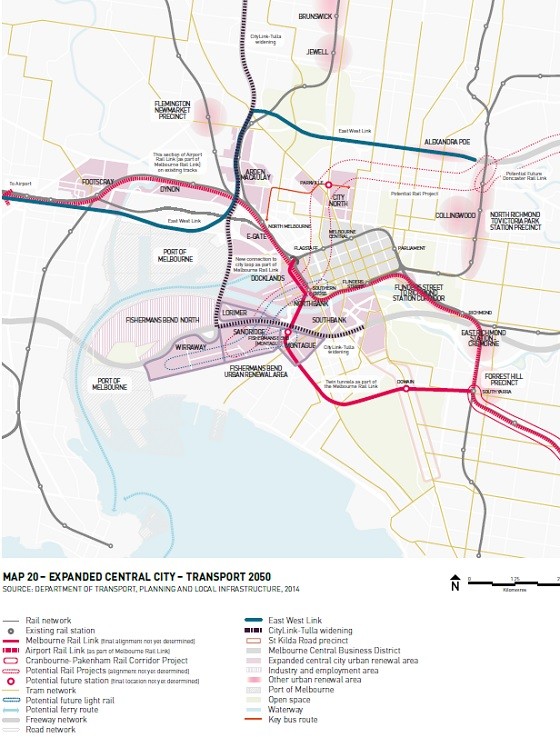
The Victorian Government’s proposed new rail tunnel, Melbourne Rail Link, has been criticised in the media on a number of counts since it was announced it would replace the previous scheme, Melbourne Metro.
Complaints about the proposal include the location of the new Montague station intended to serve the Fishermans Bend Urban Renewal Area; and dropping new stations at Parkville and Arden proposed under Metro.
It’s also been panned for reducing the number and importance of the stations some lines will have access to on the city loop; as well as doing nothing to help relieve tram congestion on Swanston St and St Kilda Rd.
These are all substantive areas for debate (e.g. see Are these criticisms of Melbourne Rail Link salient?), but they’re not the key rationale for the tunnel. There’s a danger that how well the new scheme performs on basics like capacity, reliability and cost might be overlooked.
Here’re some important points to consider when assessing the merits of Melbourne Rail Link, particularly in comparison with the Melbourne Metro scheme it replaces.
First, the purpose of the new tunnel under both schemes is to increase the capacity and reliability of the rail system so it can accommodate the next major increment in patronage growth.
That’s vital to support continued growth of the CBD. The tunnel contributes to this objective by providing an extra pair of tracks through the city centre.
Second, the tunnel is only one of the steps required to achieve this objective. While the time frames differ, the plan under both schemes is to use the extra capacity provided by the tunnel to make all lines independent of each other.
That requires that some lines will discontinue using the city loop. For example, it’s proposed under both schemes that trains on the Pakenham/Cranbourne line will no longer run around the loop and return to their destination. Likewise, Sunbury trains will no longer reverse direction via the loop. (1)
These two lines will instead be joined to form a single end-to-end service. Trains will be routed from Pakenham/Cranbourne through the CBD and on to Sunbury (and eventually the new airport line) under both schemes.
The trade-off for the greater operational robustness this will provide is Cranbourne/Pakenham – Sunbury/Airport trains won’t stop at all loop stations; they’ll only stop at two.
Changes in access to CBD stations is a legitimate basis for assessing the Government’s plan for the rail system, but they’ll mostly be the result of the shift to a “metro-style” system rather than to the alignment of the tunnel.
Third, the particular CBD stations that trains on the competing tunnels will stop at isn’t the critical issue. In both cases the tunnel will only be one of six lines. There’s no necessary reason why it needs to be the “premier” one. What matters is how it enables all six lines to operate as a reliable system with capacity for expansion.
Fourth, while new stations on the edge of the CBD and improved tram operations are desirable, they’re not the main game. The government isn’t spending $8.5-11 billion to provide rail access to Montague (or Parkville) and/or to reduce tram congestion on Swanston St; there’re much cheaper solutions for that.
They’re certainly a valid basis for assessing the desirability of the competing schemes at the margin (and they contribute to the BCR for each), however they’re essentially a bonus.
So, how well each project improves the efficiency of the network by increasing system capacity and reliability is the critical issue. The Government says Melbourne Rail Link will run more trains in the peak than Metro, but hasn’t explained how it’s made that calculation.
Another important question is cost. The Government says Melbourne Rail Link is significantly cheaper than Metro, but hasn’t explained that calculation either. It’s based on much less reliable information, especially in relation to engineering issues, than that underpinning the cost estimate for Metro. Moreover, there’s a risk it will continue to be rushed to meet political objectives.
The Government has announced its plan; now it needs to convince the electorate that the changes really are as good as claimed. If it withholds the necessary information it invites the suspicion that this is another con job.
________________
-
The planners of the Melbourne Metro tunnel proposed it would carry Cranbourne/Pakenham – Sunbury/Airport trains operating as an end-to-end line, with stops in the CBD at Flinders St and Melbourne Central stations. The Government is taking a different approach; it intends to shift Frankston and Lilydale/Belgrave services to the Melbourne Rail Link tunnel and operate them as a single end-to-end service, with stops in the CBD at Southern Cross, Flagstaff, Victoria Central and Parliament. It also plans to run Cranbourne/Pakenham – Sunbury/Airport trains as an end-to-end service, but on existing tracks with stops in the CBD at Flinders St and Southern Cross stations.








Crikey is committed to hosting lively discussions. Help us keep the conversation useful, interesting and welcoming. We aim to publish comments quickly in the interest of promoting robust conversation, but we’re a small team and we deploy filters to protect against legal risk. Occasionally your comment may be held up while we review, but we’re working as fast as we can to keep the conversation rolling.
The Crikey comment section is members-only content. Please subscribe to leave a comment.
The Crikey comment section is members-only content. Please login to leave a comment.